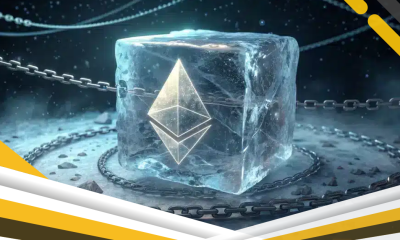Ethereum: Can Fusaka offset selling pressure from a 2mln ETH unlock?

Ethereum, the leading smart contract platform, is currently navigating a period of significant market dynamics. On one side, a substantial quantity of staked Ether (ETH) is poised to unlock, potentially introducing selling pressure. On the other, the network is gearing up for a major technical overhaul with the eagerly anticipated Fusaka upgrade. This confluence of events raises a critical question: Can the enhancements brought by Fusaka effectively counterbalance the potential selling pressure from a 2 million ETH unlock?
The Looming 2 Million ETH Unlock
The Ethereum network is approaching a notable shift in its supply dynamics. Data indicates that nearly 2 million ETH are currently queued to unlock from staking, representing a significant volume of Ether that could potentially become liquid in the near future. This validator exit queue has seen a substantial increase, at one point surging to over 2.5 million ETH, marking it as the largest pending withdrawal wave since the inception of staking on Ethereum. It is important to note that this ETH is simply waiting in line and has not yet entered the open market.
Concurrently, the amount of ETH held on centralized exchanges has been consistently declining, reaching multi-year lows. Recent data suggests that ETH exchange reserves have fallen to approximately 15.9 million ETH, a level not seen in over three years. Other reports indicate that exchange reserves are as low as 13.3 million ETH, a stark reduction from a high of around 35.5 million ETH in August 2020, with only about 10% of Ethereum’s total circulating supply available on exchanges. This shrinking supply on exchanges, coupled with a large batch of ETH about to become liquid from staking, sets the stage for a potential supply shock where increased demand could meet reduced immediate availability.
Understanding the Fusaka Upgrade
Amidst these supply-side considerations, Ethereum is preparing for its next major network upgrade, dubbed “Fusaka,” scheduled for mainnet activation on December 3, 2025. This hard fork is a critical step in Ethereum’s ongoing roadmap, focusing primarily on enhancing scalability, efficiency, and reducing transaction costs, particularly for Layer 2 (L2) solutions.
Key features of the Fusaka upgrade include:
- **Increased Transaction Throughput:** Fusaka aims to significantly expand Ethereum’s transaction capacity by raising the block gas limit from 45 million to 150 million. This allows the network to process a greater number of transactions, smart contracts, and other operations within each new block.
- **Peer Data Availability Sampling (PeerDAS):** Introduced via EIP-7594, PeerDAS revolutionizes how validators handle Layer 2 data. Instead of downloading entire data “blobs,” validators can verify small, randomly sampled portions of this data. This significantly reduces bandwidth and storage requirements, making the network more efficient and scalable for rollups, and potentially allowing for an 8x increase in blob space.
- **Lower Gas Fees:** By enhancing network efficiency and scalability, Fusaka is expected to deliver reduced gas costs, especially benefiting transactions on L2 networks.
- **Improved Validator Performance and Decentralization:** The upgrade streamlines data and validator operations, potentially reducing hardware requirements for running nodes and thereby supporting greater decentralization.
Fusaka builds upon the foundational improvements from previous upgrades like Shanghai and Dencun, further advancing Ethereum’s capacity to handle massive transaction volumes while upholding its commitment to decentralization and security.
Historical Precedent: Upgrades as Catalysts
Historically, significant Ethereum network upgrades have often acted as catalysts for positive market movements. For instance, the preceding Pectra upgrade coincided with a notable 58% rally in ETH’s price. These upgrades typically improve the network’s underlying technology, making it more robust, efficient, and attractive for users and developers. Such enhancements can lead to increased adoption, higher transaction volumes, and a strengthened ecosystem, which often translates into positive price action.
Fusaka vs. Selling Pressure: A Balancing Act
The impending unlock of 2 million ETH presents a scenario where a large supply could theoretically enter the market, potentially creating downward price pressure. However, the current low levels of ETH on exchanges suggest that a significant portion of the circulating supply is being held off-exchange, possibly in private wallets or staking contracts, indicating a long-term bullish sentiment among many investors.
This is where the Fusaka upgrade could play a pivotal role. By delivering substantial efficiency gains, lower gas costs, and faster L2 throughput, Fusaka is expected to significantly strengthen network usage metrics and overall utility. If the upgrade successfully makes Ethereum a more attractive and cost-effective platform for decentralized applications and transactions, it could stimulate increased demand for ETH. This surge in demand, coupled with the already dwindling exchange reserves, could potentially absorb the newly unlocked ETH without causing a drastic price decline. The structural improvements from Fusaka might amplify the “supply crunch” scenario, where increased utility creates strong buying pressure that offsets or even overcomes the selling pressure from unstaked ETH.
Conclusion
Ethereum finds itself at a critical juncture, balancing the potential impact of a substantial ETH unlock with the anticipated positive effects of the Fusaka upgrade. While the release of 2 million ETH from staking could introduce selling pressure, the historically low levels of ETH on exchanges and the network’s continuous technological advancements provide a compelling counter-narrative. The Fusaka upgrade, with its focus on enhanced scalability, reduced costs, and improved efficiency, has the potential to act as a significant demand driver. The interplay between these supply and demand dynamics will likely determine Ethereum’s trajectory in the coming months, shaping whether the network enters 2026 with continued momentum or faces a period of volatility.












